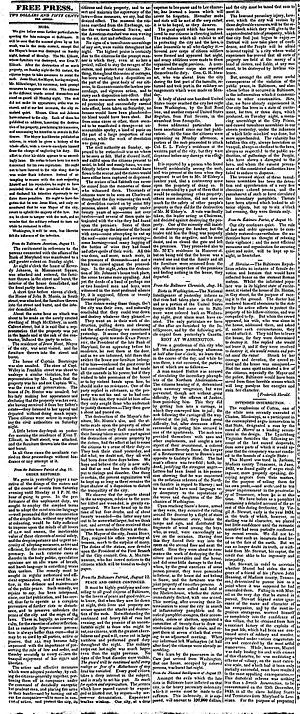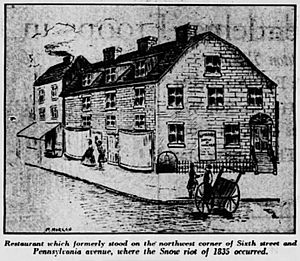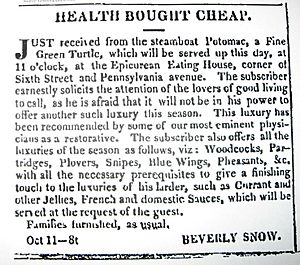Snow Riot facts for kids
The Snow Riot was a violent event in Washington, D.C. in August 1835. White mobs attacked free Black people and their businesses. The riot caused a lot of damage to places owned by Black people. It got its name from Beverly Snow's Epicurean Eating House, a restaurant owned by a free Black man, which was one of the first places attacked.
The riot also targeted a school that Arthur Bowen attended. People thought the school was teaching about ending slavery. White workers were upset because free Black people could get jobs, and they felt Black workers were taking their jobs. This anger led to violence against Black communities. The riot started on August 12, 1835, and lasted for several days. It only stopped when President Andrew Jackson stepped in.
Contents
What Caused the Snow Riot?
The Snow Riot happened 25 years before the American Civil War. In 1835, Washington, D.C., had strong disagreements between people who wanted to end slavery (called abolitionists) and those who supported it. Tensions were high because a slave uprising led by Nat Turner had happened just a few years earlier in 1831. Fear spread across the slave states, including D.C.
Abolitionists were sending many requests to Congress to end slavery in the capital. There were so many that the House of Representatives passed "gag rules" to automatically ignore them. At the same time, many white people wanted to get back at Black people for the 1831 uprising.
The Arthur Bowen Incident
The riot was sparked by an event involving a slave named Arthur Bowen. He entered his owner Anna Thorton's bedroom with an axe. Bowen did not hurt anyone. However, the idea that a slave could try to rebel made slavery supporters in the city very angry. Bowen was taken into custody safely.
This incident gave people who supported slavery a chance to go after Reuben Crandall. They believed Crandall was spreading information about ending slavery in Washington. Francis Scott Key, who wrote the U.S. national anthem, was involved in Crandall's arrest and trial. Crandall was found innocent, which was embarrassing for Key and ended his political career.
That summer, federal workers had their first labor strike. This was the 1835 Washington Navy Yard labor strike, which began on July 29, 1835. It started when Commodore Isaac Hull limited workers' lunch breaks because of thefts. The workers at the Navy Yard wanted a ten-hour workday and for Hull to change his order.
This strike quickly showed the racial problems at the Navy Yard. Commodore Hull wrote a letter saying that 175 white workers had joined the strike. This was the first strike by federal shipyard workers.
An African-American diarist named Michael Shiner wrote about white workers trying to stop Black workers from doing their jobs. He mentioned a rumor about a Black man named Snow who supposedly said disrespectful things about the workers' wives. Snow owned a restaurant. White workers gathered at Snow's restaurant and destroyed it. They also threatened to go to the Navy Yard after Commodore Hull.
After destroying Snow's restaurant, the workers drank all his alcohol. Snow had escaped, so the rioters could not find him. Mobs of white people continued to attack all businesses run by free Black people, including schools, churches, and other shops.
Why the Riot Became a Race Riot
The strike "quickly turned into a race riot." White workers from the Washington Navy Yard were striking and took their anger out on the Black community. They heard a rumor that Beverly Snow, a free Black restaurant owner, had insulted their wives and daughters.
The mob first attacked Snow's Epicurean Eating House. They searched for Snow because he was a successful free Black business owner. But they could not find him. The United States Telegraph, a newspaper that supported slavery, said the mob's actions were mainly about money. They wrote that Black people were "entering into competition for work at a lower rate."
Josephine Seaton, whose father published a newspaper, wrote about the strike and riot. She noted that many Navy Yard workers were jobless. They, along with their supporters, formed the mob. She saw that racism was hurting the Navy Yard workforce. White workers blamed their own money problems on both free and enslaved African Americans.
After days of chaos, President Andrew Jackson ordered U.S. Marines to stop the riot. The Navy Yard strike ended on August 15, 1835. The striking workers were allowed to return to work, but they gained little. The riot left a deep distrust between races. The Black community suffered the most. They received no payment for their destroyed homes and churches. Instead, the city council quickly passed a new rule that stopped Black people (not their attackers) from gathering after sunset. For a long time, the history of the strike and the Snow Riot was kept quiet because it was an embarrassment.
Who Was Beverly Snow?
Beverly Randolph Snow was born around 1799 in Lynchburg, Virginia. He was born into slavery on Captain William Norvell's property. Norvell's will stated that Snow would be given to his daughter, Susannah Norvell Warwick, and would be freed at age 30.
The Norvell family allowed Snow to run a small oyster shop in Lynchburg. He was allowed to keep some of the money he earned. During this time, Snow married a free woman named Julia. Snow was freed in November 1829. He and Julia left Virginia, which had strict rules for free Black people, and moved to Washington, D.C.. Snow was different from many free Black people because he was educated, wealthy, and successful. He was one of several Black business owners in the city center. His success showed how strong Washington's free Black population was.
In Washington, D.C., Snow opened a popular restaurant called the Epicurean Eating House. It was located on the corner of 6th Street and Pennsylvania Avenue. Snow's success made some white people jealous and angry.
Snow's restaurant focused on fancy and healthy food. He cleverly advertised it with the message "Health Bought Cheap." In August 1835, large groups of white workers went through the city. They wanted to destroy property and scare free Black people. The mob, made up of striking workers from the Washington Navy Yard, had heard a rumor that Snow had insulted their wives. They also disliked Snow's business success. Many rioters entered his restaurant looking for him and "busted up the entire facility." They drank all the alcohol. The mob then yelled, "Now for Snow's house!" They broke in, looked for anti-slavery writings, and destroyed the furniture. Since they could not find Beverly, the mob attacked Black schools and churches. The riot in Washington D.C. in August 1835 became known as the "Snow Riot" or "Snow Storm."
What Happened to Beverly Snow After the Riot?
The Snows escaped from the rioters. After getting away, Snow and his wife, Julia, moved to Toronto, Canada. There, he opened another successful restaurant. His first business was a coffee shop. Later, he opened the Epicurean Recess, then the Phoenix Saloon in 1848, and the Exchange Saloon in 1856. Snow died in Toronto on October 21, 1856. He is buried in the Toronto Necropolis with his wife, Julia.
See also
 In Spanish: Disturbio racial de Washington D. C. de 1835 para niños
In Spanish: Disturbio racial de Washington D. C. de 1835 para niños




